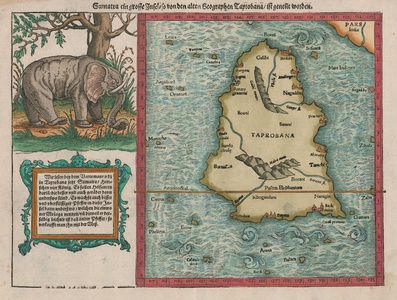| Method | Woodcut with hand colour |
| Artist | Münster, Sebastian |
| Published | [Basel, c.1574] |
| Dimensions | 315 x 358 mm |
| Notes |
Munster's map of the Ptolemaic island of Taprobana, most likely modern Sri Lanka, from the 1574 German edition of the Cosmographia. The map, first published in 1540 in Munster's edition of Ptolemy's Geographia, was originally entitled Tabula Asiae XII and closely followed the cartography of Waldseemuller. Although his cartography matches earlier examples, Munster differed from his contemporaries in identifying the island described as Taprobana by the classical geographers as Sumatra, rather than Sri Lanka. In 1588, the map was completely recut, abandoning the Ptolemaic model in favour of a new and relatively advanced map of Sumatra and parts of the Malay peninsula, though retaining the title and the attribution of 'Taprobana.' The current map more closely resembles the teardrop shape of Sri Lanka, though at first glance, the location of the small part of mainland 'India' in the top right of the block and the inclusion of the equator makes the suggestion of Sumatra compelling. In reality though, Munster's attribution seems to be a casualty of his attempts to consolidate classical narratives for the far east with the burgeoning familiarity of Europe at the time with Sri Lanka and India more generally, particularly through the reports of Portuguese merchants. In most classical models of the known world, Taprobana was described as a very large island in the Erythraean Sea, south of the landmass of India. The geographical reality of Sri Lanka's size seems to have been Munster's most compelling argument against its identification as Taprobana, and also account for the location of 'India' and the inclusion of the equator in early modern attempts to map it. The map is further embellished with a large vignette of an elephant, representing the island's famous ivory trade, and a large descriptive cartouche. The elephant is distinctive, featuring a scooped trunk and padded feet in the style often seen in medieval bestiaries, and indeed it bears no small resemblance to the large elephant featured on the depiction of Taprobana on the famous 14th century Catalan Atlas. Sebastian Münster (20th January 1488 - 26th May 1552) was a German cartographer, cosmographer, and theologian. A gifted scholar of Hebraic, Münster originally joined the Franciscans, but left the order in favour of the Lutheran Church. He was appointed to the University of Basel in 1529, and published a number of works in Latin, Greek, and Hebrew. His most celebrated works are his Latin edition of Ptolemy's Geographia in 1540, and the Cosmographia in 1544. The Cosmographia was the earliest German description of the world, an ambitious work of 6 volumes published in numerous editions in German, Latin, French, Italian, and Czech. Henricus Petrus (1508-1579) was a German printer and published, whose print-works in Basel produced some of the most influential works of the German Renaissance, including Copernicus' De revolutionibus orbium coelestium and Munster's Cosmographia. Condition: Central vertical fold as issued. Time toning to edges of sheet. German letterpress title and decorative block on verso. |
| Framing | unmounted |
| Price | £500.00 |
| Stock ID | 51927 |

